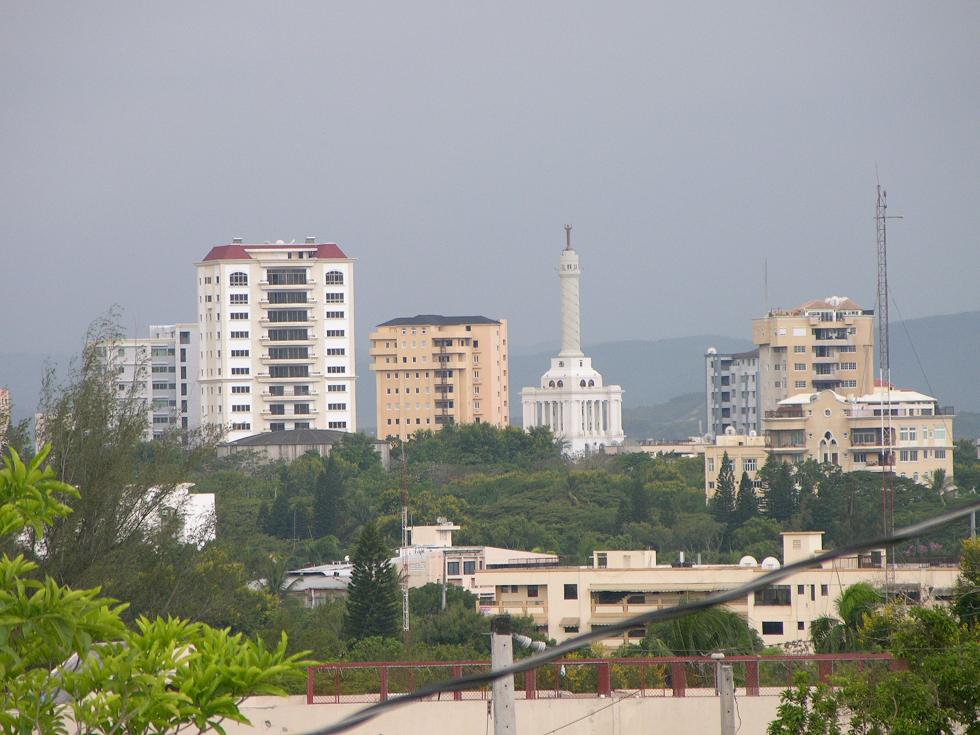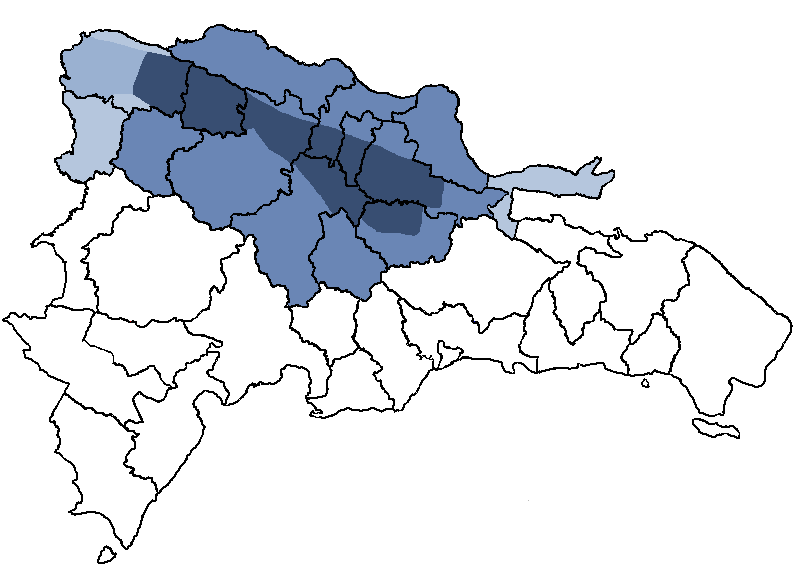Cibao on:
[Wikipedia]
[Google]
[Amazon]
The Cibao, usually referred as El Cibao, is a region of the
 El Cibao occupies the central and northern part of the Dominican territory. To the north and east of the region lies the
El Cibao occupies the central and northern part of the Dominican territory. To the north and east of the region lies the
 The valley is not only a geographical unit, but also a cultural and linguistic unit. The Cibao region is considered to be the cultural heartland of the Dominican Republic. The typical accent spoken in the Cibao region is a mixture of two dialects: that of the 16th- and 17th-century Portuguese colonists in the Cibao valley, and of the 18th-century Canarian settlers. There is also some influences from African languages in the dialect.
Merengue music, played using the güira, tambora and
The valley is not only a geographical unit, but also a cultural and linguistic unit. The Cibao region is considered to be the cultural heartland of the Dominican Republic. The typical accent spoken in the Cibao region is a mixture of two dialects: that of the 16th- and 17th-century Portuguese colonists in the Cibao valley, and of the 18th-century Canarian settlers. There is also some influences from African languages in the dialect.
Merengue music, played using the güira, tambora and  During Late January and through February, several carnivals are held within the region. The most popular of these festivals belongs to the province of La Vega, and dates back to the first European settlements. It began as a religious activity celebrating the pre-Lent season, and the carnival's theme revolves around the victory of good over evil.
Many important Dominican patriots were of Cibaenian origin. Among the most important are local generals José Desiderio Valverde and José Antonio Salcedo, who were responsible for the restoration of the Republic in the later decades of the 1800s. During the Trujillo dictatorship, the Mirabal sisters arranged clandestine organizations to rebel against the fascist dictatorship. The sisters were brutally murdered in 1960, and remain today as some of the biggest martyrs on behalf of the Dominican nation.
The bulk of the population is mainly concentrated in the center of the region. The city of
During Late January and through February, several carnivals are held within the region. The most popular of these festivals belongs to the province of La Vega, and dates back to the first European settlements. It began as a religious activity celebrating the pre-Lent season, and the carnival's theme revolves around the victory of good over evil.
Many important Dominican patriots were of Cibaenian origin. Among the most important are local generals José Desiderio Valverde and José Antonio Salcedo, who were responsible for the restoration of the Republic in the later decades of the 1800s. During the Trujillo dictatorship, the Mirabal sisters arranged clandestine organizations to rebel against the fascist dictatorship. The sisters were brutally murdered in 1960, and remain today as some of the biggest martyrs on behalf of the Dominican nation.
The bulk of the population is mainly concentrated in the center of the region. The city of

Dominican Republic
The Dominican Republic is a country located on the island of Hispaniola in the Greater Antilles of the Caribbean Sea in the Atlantic Ocean, North Atlantic Ocean. It shares a Maritime boundary, maritime border with Puerto Rico to the east and ...
located in the northern part of the country. As of 2009, the Cibao region has a population of 5,622,378, making it the most populous region in the country.
The region constitutes a "developed macro-region"; with a large industrial base and high levels of progress among its inhabitants, it has the highest levels of education and the highest quality of life among the three main regions of the Dominican Republic. Cibao is social-culturally characterized by being the predominant center of the European legacy on the island, and economically for being the most prosperous region in the country.
Etymology
The word Cibao, ; . Cibao was a native name for the island, although the Spanish used it during the Spanish conquest to refer to the rich and fertile valley between the Central and Septentrional mountain ranges.Geography and economy
 El Cibao occupies the central and northern part of the Dominican territory. To the north and east of the region lies the
El Cibao occupies the central and northern part of the Dominican territory. To the north and east of the region lies the Atlantic Ocean
The Atlantic Ocean is the second largest of the world's five borders of the oceans, oceanic divisions, with an area of about . It covers approximately 17% of Earth#Surface, Earth's surface and about 24% of its water surface area. During the ...
; to its west lies the Republic of Haiti and to the south the Central Range, which separates El Cibao from the other natural regions.
The Cordillera Central mountain range is located within El Cibao, containing the highest peak in all of the Caribbean, Pico Duarte. Two of the largest rivers of the country are also located inside this region: the Yaque del Norte, the largest river of the Dominican Republic
The Dominican Republic is a country located on the island of Hispaniola in the Greater Antilles of the Caribbean Sea in the Atlantic Ocean, North Atlantic Ocean. It shares a Maritime boundary, maritime border with Puerto Rico to the east and ...
, and the Yuna river. Both of these rivers contain several chains of dams used to provide the region with water for irrigation (since agriculture is the main activity of the area) and hydroelectric energy. Rice
Rice is a cereal grain and in its Domestication, domesticated form is the staple food of over half of the world's population, particularly in Asia and Africa. Rice is the seed of the grass species ''Oryza sativa'' (Asian rice)—or, much l ...
, coffee
Coffee is a beverage brewed from roasted, ground coffee beans. Darkly colored, bitter, and slightly acidic, coffee has a stimulating effect on humans, primarily due to its caffeine content, but decaffeinated coffee is also commercially a ...
and cacao are the most important crops grown in the area.
The central mountain range also has important mining activity. Its main mineral resources include gold
Gold is a chemical element; it has chemical symbol Au (from Latin ) and atomic number 79. In its pure form, it is a brightness, bright, slightly orange-yellow, dense, soft, malleable, and ductile metal. Chemically, gold is a transition metal ...
, iron
Iron is a chemical element; it has symbol Fe () and atomic number 26. It is a metal that belongs to the first transition series and group 8 of the periodic table. It is, by mass, the most common element on Earth, forming much of Earth's o ...
and nickel, among others. The largest gold mine in the Americas and second largest in the world, the Pueblo Viejo mine, is located in the Cibao region. The internationally known Barrick Gold and Falconbridge Falconbridge may refer to:
*Falconbridge Ltd., a Canadian mining company
*Falconbridge, Middlesex County, Ontario
*Falconbridge, Greater Sudbury, Ontario
People with the surname
*Lord Falconbridge, an alternative title for barons, viscounts, and e ...
are the companies in charge of the extraction of these ores.
Culture
 The valley is not only a geographical unit, but also a cultural and linguistic unit. The Cibao region is considered to be the cultural heartland of the Dominican Republic. The typical accent spoken in the Cibao region is a mixture of two dialects: that of the 16th- and 17th-century Portuguese colonists in the Cibao valley, and of the 18th-century Canarian settlers. There is also some influences from African languages in the dialect.
Merengue music, played using the güira, tambora and
The valley is not only a geographical unit, but also a cultural and linguistic unit. The Cibao region is considered to be the cultural heartland of the Dominican Republic. The typical accent spoken in the Cibao region is a mixture of two dialects: that of the 16th- and 17th-century Portuguese colonists in the Cibao valley, and of the 18th-century Canarian settlers. There is also some influences from African languages in the dialect.
Merengue music, played using the güira, tambora and accordion
Accordions (from 19th-century German language, German ', from '—"musical chord, concord of sounds") are a family of box-shaped musical instruments of the bellows-driven free reed aerophone type (producing sound as air flows past a Reed (mou ...
, was originated in El Cibao. The original folk type of merengue is known as ''perico ripiao'' or ''típico'', which is played to this day by local musical groups, as a variation of the merengue, with a faster pace.
 During Late January and through February, several carnivals are held within the region. The most popular of these festivals belongs to the province of La Vega, and dates back to the first European settlements. It began as a religious activity celebrating the pre-Lent season, and the carnival's theme revolves around the victory of good over evil.
Many important Dominican patriots were of Cibaenian origin. Among the most important are local generals José Desiderio Valverde and José Antonio Salcedo, who were responsible for the restoration of the Republic in the later decades of the 1800s. During the Trujillo dictatorship, the Mirabal sisters arranged clandestine organizations to rebel against the fascist dictatorship. The sisters were brutally murdered in 1960, and remain today as some of the biggest martyrs on behalf of the Dominican nation.
The bulk of the population is mainly concentrated in the center of the region. The city of
During Late January and through February, several carnivals are held within the region. The most popular of these festivals belongs to the province of La Vega, and dates back to the first European settlements. It began as a religious activity celebrating the pre-Lent season, and the carnival's theme revolves around the victory of good over evil.
Many important Dominican patriots were of Cibaenian origin. Among the most important are local generals José Desiderio Valverde and José Antonio Salcedo, who were responsible for the restoration of the Republic in the later decades of the 1800s. During the Trujillo dictatorship, the Mirabal sisters arranged clandestine organizations to rebel against the fascist dictatorship. The sisters were brutally murdered in 1960, and remain today as some of the biggest martyrs on behalf of the Dominican nation.
The bulk of the population is mainly concentrated in the center of the region. The city of Santiago de los Caballeros
Santiago de los Caballeros ("James, son of Zebedee, Saint James of the Knights"), often shortened to Santiago, is the second-largest city in the Dominican Republic and the fourth-largest city in the Caribbean by population. It is the capital of ...
constitutes the regional center and main focus of development of the area.
Provinces

References
{{Authority control Geography of the Dominican Republic